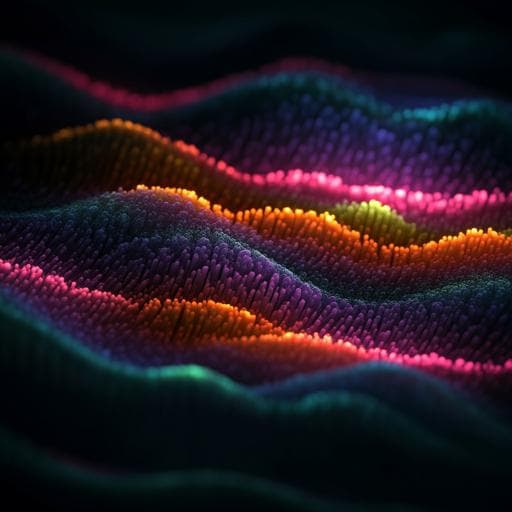
Physics
High anisotropy in electrical and thermal conductivity through the design of aerogel-like superlattice (NaOH)<sub>0.5</sub>NbSe<sub>2</sub>
R. Sun, J. Deng, et al.
Discover how Ruijin Sun and colleagues have achieved interlayer decoupling in bulk materials, showcasing unique electric and vibrational properties. This groundbreaking research reveals a superlattice of NbSe2 and porous hydroxide layers that enhances 2D superconductivity and CDW transition temperature, paving the way for large-scale production of advanced materials.
~3 min • Beginner • English
Introduction
The study addresses how to achieve interlayer decoupling in bulk crystals so that they emulate the distinctive electronic and vibrational properties of monolayers. While monolayer 2D materials exhibit enhanced or novel behaviors due to the absence of interlayer coupling—such as enhanced CDW order and Ising superconductivity in monolayer NbSe2—bulk materials are typically constrained by periodic stacking and interlayer interactions. Existing approaches to reduce coupling in few-layer systems use twist angles or lattice mismatch, and computational studies emulate decoupling by inserting vacuum layers. However, a practical bulk route that simultaneously blocks electron and phonon transport and realizes intrinsic 2D properties in large crystals is lacking. The authors propose introducing highly porous, aerogel-like hydroxide layers as superinsulating block layers between NbSe2 monolayers to spatially, electrically, and vibrationally decouple them, thereby enabling bulk crystals to mimic monolayer behavior while retaining bulk advantages of size and stability.
Literature Review
The paper situates its contribution within research on 2D materials following graphene, where monolayers show properties distinct from bulk (e.g., direct band gaps in MoS2, enhanced CDW and Ising superconductivity in NbSe2). Decoupling strategies in few-layer systems include large twist angles and lattice mismatch. A related bulk superlattice, Ba3Nb11S28, spatially separates conducting NbS2 layers with insulating blocks and exhibits 2D superconductivity but retains metallic interlayer conduction, indicating incomplete electronic decoupling; moreover, traditional block layers do not effectively impede phonon transport. Aerogels are highlighted for extremely low thermal conductivity due to high porosity and structural disorder, inspiring the use of aerogel-like hydroxide layers as phonon and electron blockers. Prior works on thermal anisotropy in layered and superlattice materials, and the enhanced CDW and Ising superconductivity in monolayer NbSe2, provide comparative benchmarks.
Methodology
- Synthesis: Large single crystals of (AOH)xMX2 (A = Na, K; M = Ta, Nb; X = S, Se) were synthesized hydrothermally using MX2 crystals grown by iodine vapor transport (730–700 °C, 15 days) as precursors. Thiourea and AOH were dissolved in ammonium sulfide solution; MX2 crystals were added; autoclaves were heated at 100–130 °C for 130 h.
- Structural and compositional characterization: PXRD (Rigaku SmartLab, Cu Kα) and SCXRD (Bruker D8 VENTURE, Mo Kα) were performed. Structure solved in P-3m1 with a = 3.4554 Å, c = 48.9648 Å. Maximum entropy method (MEM) and charge flipping were used to obtain electron density maps. SEM-EDS assessed elemental distributions; XPS determined chemical states and confirmed NaOH intercalation (Na1s at 1070 eV, OH at 532.4 eV; unchanged Nb3d/Se3d relative to NbSe2). Occupancies of NaOH layers were refined, showing ~5% in outer layers and ~40% in central layer, forming ~2 nm-thick NaOH trilayers between NbSe2 monolayers; interlayer spacing d ≈ 24.5 Å.
- Electrical transport: Temperature-dependent in-plane (ρab) and out-of-plane (ρc) resistivities were measured (SQUID PPMS-9 and custom system up to 18 T). ρc(T) analyzed with thermal activation model; anisotropy β = ρab/ρc compared with pristine and other intercalated TMDs.
- Raman spectroscopy: Room-temperature and temperature-dependent Raman spectra were measured to probe intra- and interlayer vibrational modes and CDW-related modes, comparing bulk NbSe2, monolayer NbSe2, and (NaOH)0.5NbSe2.
- Heat capacity: Cp(T) from 2–300 K was fitted by a combined Debye–Einstein model to quantify localized (Einstein) vs delocalized (Debye) vibrational contributions; extracted θE1, θE2, and θDebye.
- Thermal conductivity: Out-of-plane thermal conductivity κ⊥ measured via time-domain thermoreflectance (TDTR) with beam-offset analysis; in-plane κ∥ measured by steady-state heat flow method (four-contact setup in a furnace with heat-pipe).
- Magnetic torque: Torque magnetometry at 1 T measured angular-dependent torque τ(φ, T) to identify CDW onset and symmetry via susceptibility tensor anisotropy.
- DFT calculations: VASP (GGA-PBE, PAW, DFT-D3), plane-wave cutoff 500 eV; k-grid resolution 0.02×2π Å−1 (self-consistent) and 0.01×2π Å−1 (Fermi surface). H positions added and relaxed; lattice constants from experiment. CASTEP used for interlayer coupling energy vs separation; k-grid 8×8×1; convergence thresholds specified. Band structures and Fermi surfaces computed for bulk, monolayer, and (NaOH)0.5NbSe2; interlayer coupling energy E computed for varying NaOH occupancy (Occ).
Key Findings
- Structure and composition:
- (NaOH)0.5NbSe2 forms a trigonal superlattice (P-3m1) with a = 3.4554 Å, c = 48.9648 Å, comprising NbSe2 monolayers separated by ~2 nm trilayers of highly porous NaOH.
- Interlayer spacing between NbSe2 layers expands to d ≈ 24.5 Å (≈4× pristine NbSe2 at 6.14 Å), confirming spatial detachment.
- Outer NaOH layers have ~5% occupancy, central NaOH layer ~40%; outer-layer density ≈ 0.08 g cm−3 (within aerogel range).
- XPS shows Na+ and OH− signals and unchanged Nb/Se binding energies, indicating NaOH intercalation without charge transfer to NbSe2.
- Electronic decoupling and transport:
- Along a-axis, (NaOH)0.5NbSe2 remains metallic; along c-axis it becomes insulating with ρc up to 10^6 times higher than NbSe2 and thermally activated behavior.
- Electrical anisotropy β reaches extremely large values across the (AOH)xMX2 family; for (NaOH)0.5NbSe2, βmax > 2,000,000, far exceeding intercalated or superlattice references (e.g., Ba3Nb11S28 ~10^3).
- DFT shows (NaOH)0.5NbSe2 has monolayer-like bands: Se pz bands sink below EF; Nb 4d band degeneracy preserved; Fermi surface shows negligible kz dispersion (flat Γ–A), indicating eliminated interlayer electronic coupling.
- Vibrational decoupling and phonon transport:
- Raman: Interlayer shear mode (20–30 cm−1) absent in (NaOH)0.5NbSe2, as in monolayer NbSe2; intra-layer modes (E2g ~250 cm−1, A1g ~220 cm−1, soft mode 150–200 cm−1) retained.
- Heat capacity: Debye–Einstein fit yields θE1 = 128 K, θE2 = 174 K, θDebye = 237 K; Einstein (localized) modes contribute ~91% of specific heat, evidencing localized vibrations due to weak interlayer bonding and sparse NaOH occupancy.
- Out-of-plane thermal conductivity κ⊥ ≈ 0.28 W m−1 K−1 at 300 K (TDTR), ~7% of bulk NbSe2; among the lowest in bulk inorganic materials.
- In-plane thermal conductivity κ∥ ≈ 98.1 W m−1 K−1 at 300 K, giving anisotropy A = κ∥/κ⊥ ≈ 350, surpassing pyrolytic graphite (A ≈ 340) and second only to misoriented MoS2 films.
- DFT interlayer coupling energy E ≈ 2.5 meV/Å2 (~9% of bulk NbSe2 ≈ 25 meV/Å2); E scales with NaOH occupancy, reaching ~29 meV/Å2 at Occ = 1.0.
- Correlated states:
- CDW: Temperature-dependent Raman shows emergence of CDW amplitude (~75 cm−1) and folding (~190 cm−1) modes above 110 K; intensity vanishes between 110–140 K, indicating TCDW > 110 K (vs 33 K in bulk NbSe2), consistent with monolayer enhancement.
- Torque magnetometry: τ(φ) retains sin(2φ) (D3h symmetry) across CDW transition; onset of enhanced torque amplitude in (NaOH)0.5NbSe2 occurs >120 K, corroborating elevated TCDW.
- Superconductivity: ρab shows onset near 1.7 K and zero resistance at ~1.2 K; Halperin–Nelson behavior for 1.5 K < T < 1.8 K indicates BKT-like 2D fluctuations.
- Upper critical field anisotropy and Pauli violation: PVR μ0Hc2(0)/μ0HP up to ~4.0, comparable to monolayer NbSe2; superconductivity consistent with Ising pairing without FFLO; γ ≈ 32.5 (SC anisotropy) exceeds related superlattices.
Discussion
Introducing highly porous, aerogel-like NaOH layers between NbSe2 monolayers effectively suppresses interlayer electron and phonon transport, thereby decoupling the layers within a bulk crystal. This approach reproduces monolayer-like electronic band structures and Fermi surfaces, eliminates interlayer vibrational modes, and drastically reduces interlayer coupling energy and through-plane thermal conductivity. The electrical response becomes uniaxially insulating along c while remaining metallic in-plane, confirming electronic decoupling. The enhanced CDW transition temperature (>110 K) and Pauli-limit-violating Ising superconductivity with 2D BKT-like fluctuations mirror monolayer NbSe2 behavior, demonstrating that intrinsic 2D properties can be realized at macroscopic scales without exfoliation. Compared to traditional insulating block layers in superlattices (e.g., Ba3Nb11S28), the aerogel-like layers achieve superior suppression of both electron and phonon transport, leading to record-high anisotropies and ultralow interlayer coupling. The occupancy-dependent interlayer energy highlights porosity as a key design parameter for decoupling efficacy. The methodology suggests a generalizable platform for engineering bulk materials with intrinsic 2D properties across TMDs and potentially other layered systems.
Conclusion
The work demonstrates a bulk route to interlayer decoupling by inserting aerogel-like NaOH block layers into NbSe2, forming (NaOH)0.5NbSe2 superlattices. This design yields: (1) ideal uniaxial insulating behavior along c with extreme electrical anisotropy; (2) monolayer-like electronic bands and Fermi surfaces; (3) strong vibrational decoupling evidenced by absent interlayer shear modes, dominant Einstein-like local vibrations, ultralow interlayer coupling energy (2.5 meV/Å2), and κ⊥ = 0.28 W m−1 K−1; and (4) monolayer-analogous correlated states with enhanced CDW (TCDW > 110 K) and Pauli-breaking 2D Ising superconductivity (PVR ~4, BKT-like behavior, Tc ~1.5–1.7 K). These results validate that highly porous block layers can realize intrinsic 2D properties in bulk crystals and suggest a broadly applicable strategy to TMDs and other van der Waals materials (graphite, Xenes, BN). Future work could optimize block-layer composition and porosity, extend the approach to diverse layered materials, and explore device integration leveraging extreme anisotropies.
Limitations
- Scope and generality: While Fig. S1 indicates a family of (AOH)xMX2 compounds, detailed physical characterization is focused on (NaOH)0.5NbSe2; generalization to other systems is proposed but not comprehensively demonstrated.
- CDW transition temperature: TCDW is bracketed by the disappearance of Raman intensity between 110–140 K rather than a single sharp value.
- Superconducting regime: Tc is low (≤1.7 K), requiring ultra-low-temperature measurements; detailed vortex dynamics and full H–T phase diagrams are in supplementary data.
- Thermal measurements: κ∥ reported for 150–350 K; behavior outside this range is not shown; κ⊥ extracted via TDTR relies on thermal model fitting and assumes sample homogeneity.
- Structural details: Outer NaOH layer occupancy (~5%) and hydrogen positions are inferred from SXRD/MEM and DFT relaxation; direct visualization of hydrogen is challenging, and adsorbed surface water is noted in XPS shoulder.
- Long-term stability and environmental robustness of the aerogel-like NaOH layers within the lattice are not discussed.
Related Publications
Explore these studies to deepen your understanding of the subject.







